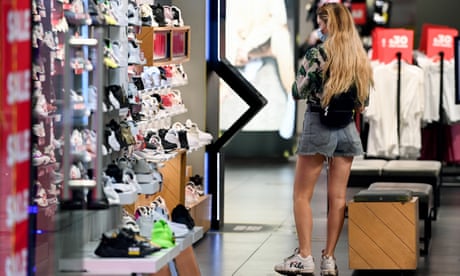- by foxnews
- 04 Mar 2025
‘People are spooked’: Australia’s January consumer confidence sinks to three-decade low over Omicron
‘People are spooked’: Australia’s January consumer confidence sinks to three-decade low over Omicron
- by theguardian
- 18 Jan 2022
- in news

Australia's consumer sentiment dived this month as worries about the explosion in Omicron Covid cases sent confidence to its lowest January level since 1992, according to the latest ANZ-Roy Morgan survey.
Consumer confidence fell 7.6% last week, sinking to its lowest rate since October 2020. Omicron case numbers surged across Australia, straining testing facilities and disrupting everything from supply chains to hairdressing salons.
All states fell below the neutral confidence level of 100, and were below the depths of the Delta Covid variant wave. All subindices were also in retreat, including current financial conditions dropping 11.3%. The number of respondents saying now was "the time to buy a major household item" also falling by a similar 11.4%.
While the reading for "future financial conditions" was down a relatively modest 4.3%, the proportion of those expecting to be worse off in a year's time rose to 19%, the most since September 2020.
Head of Australian economics at ANZ, David Plank, said "people are spooked by Omicron - obviously, case numbers, deaths unfortunately - and the difficulty of getting tested. All of that has made people apprehensive and nervous."
The low confidence reading, at 97.9, was also notable because it came in January, a time of the year typically associated with upbeat sentiment. Back in January 1992, the last time it was this low in the first month of the year, unemployment was at about 10% and rising towards 11%, Plank said.
"What really matters is the labour market conditions were very, very different [from now]," he said. Australia's November jobless rate was 4.6%, with the ABS scheduled to provide December figures this Thursday.
Plank said it remains unclear how long the effects of Omicron will sap consumers' urge to spend.
A separate ANZ report out on Thursday showed there is no sign yet of a reversal in the "Omicron malaise in spending" with a decline of 27% in the first half of January compared with the first half of December.
Previous years had seen a decline in the range of 17 to 21% for this period, with dining dropping 26% as people avoided public places. "Weakening consumer confidence through the first half of January is another sign that spending could stay weak for a while longer", the report said.
Offering some solace to businesses - and politicians facing elections soon in New South Wales, South Australia and federally - is that 2021 ended with a significant head of economic steam.
"The underlying momentum in the economy at the end of last year, and the stimulus [from governments] mean that I wouldn't be particularly worried about where the economy will end up if this fear about Omicron and the pandemic starts to ease," Plank said. "The unknown is, when does it start to ease?"
The major banks are beginning to revise their forecasts for GDP growth as they assess Omicron's disruptive effects.
The CBA has been the first to move, disclosing on Tuesday it had chopped its forecast for first-quarter growth to 1% from 2.3%, compared with the December quarter.
The prediction is that hours worked will drop 3-4% because of absenteeism and also supply issues. Damage, though, is expected to be temporary as consumers and businesses "snap back" when the Omicron wave recedes.
CBA's head of Australian economics, Gareth Aird, said the bank has for now left alone its forecasts for the second half of 2022.
"For the calendar year as a whole - that is, 2022 v 2021 - [the revision] lowers GDP growth from 5.1% to 4.8% - not a lot in the scheme of things given how big the margin of error is around forecasting at the moment," Aird said. "Some of the loss of production and spend will be permanent - but it's not a huge amount."
The fickleness of planning during a pandemic was also underscored in the ABS's release of international passenger arrivals and departure details for November.
Overseas arrivals reached 197,000 in November, while 229,000 people departed for international destinations, the most since Covid restrictions landed in March 2020, according to the ABS.
"While the number of border crossings have increased since travel restrictions were eased in November, there are still far fewer crossings than before the Covid-19 pandemic," ABS director of migration statistics, Jenny Dobak, said. "[I]n December 2019 there were 1.9 million overseas arrivals and 2.2 million overseas departures, 10 times larger than December 2021 volumes."
Qantas last week signalled how much Omicron had dimmed their outlook. It slashed domestic capacity for the March quarter to be at about 70% of pre-Covid levels, down from the 102% it had planned.
International capacity was also reduced to about 20% of pre-Covid levels from the 30% level that had been planned, as nations such as Japan, Thailand and Indonesia increased travel restrictions.
- by travelandtourworld
- descember 09, 2016
Rome's Exclusive Nightlife The Ultimate Guide to Luxury Prestige and VIP Experiences
Rome, the Eternal City, is celebrated for its awe-inspiring architecture, deep-rooted history, and electrifying nightlife. As twilight descends over the Colosseum and the city’s cobblestone streets begin to pulse with energy, discerning travelers and locals alike seek out the most exclusive experiences the city has to offer. From high-end rooftop lounges and private clubs to bespoke luxury gatherings, Rome’s nightlife is a refined blend of sophistication and indulgence.
read more


